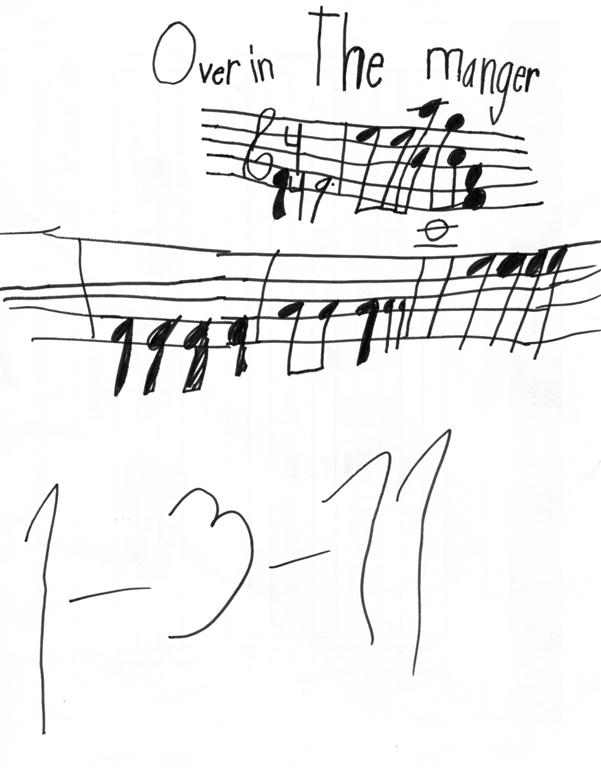Monday: We got started around 6:30 and did music stuff until 8:00. I say “music stuff” because we spent very little time with hands on the guitar. In fact, we started out with the D harmonica, which I used as an ear-training/music theory tool. I took a piece of dry-erase paper with a staff and drew 20 boxes (2 rows of 10) to correspond to the blow and draw notes of the D harmonica. Then I had M fill in the box with each note, which I would play on the harmonica and then have her find on the guitar. Because the first 9 blow notes on a diatonic harmonica are the I chord of the harmonica’s key (here, D-F#-A) repeated in 3 octaves, I had occasion to reinforce the formula for building a major chord (1-3-5).
Once we got the boxes filled out, we worked on Skip to My Lou on the harmonica. M found it a little frustrating, understandably — it’s can be hard to get a clean note on a harmonica, both because it’s hard to pucker your lips right, and because it’s easy to bend some of the notes by a half-step or more. But we stuck with it for a while.
Next, we worked on coming up with a cadenza for M to play in Suzuki’s Allegro. This is something her teacher worked on both in group class on Saturday and in M’s private lesson. M generally doesn’t do well coming up with a cadenza because she simply plays notes without having any idea of what, musically, she’s trying to do. So instead of sounding like a musical idea, her cadenzas just sound like random notes. Her teacher asked M to sing her cadenza on Saturday, saying that if you can sing it, you can play. To which I would add: If you can’t sing it (assuming you transpose it into your range), then you can’t play it, because it doesn’t have any genuine musical shape.
So I started out by having M sing on “la” while I played a simple I-IV-V chord progression. After doing that for a while, I gave M an A to start, and had her sing a little musical fragment for her cadenza. The fragment was unreliable at first; that is, she wasn’t singing it consistently the same. But she finally settled on a little two-bar tunelet. Our next step was to figure out the tune itself, which we did by having M sing and try to pick out the notes on her guitar. As we did that, I had M write the notes down on a page of dry-erase staff paper. Eventually, what we wrote down turned out to be basically two bars of Aunt Rhody, in the key of A. But that’s okay!
After all of that, all we did on the guitar was work on Suzuki’s Allegro for a while, focusing on right-hand technique. M got frustrated because I was setting demanding standards — I insisted on proper alternating fingers, and I tried to get her to place her fingers more and more carefully as we worked through it. But she calmed herself down, and she sounded okay by the time we stopped practicing.
Tuesday: It’s dance day on Tuesdays, so we only had about 15 minutes to practice. To increase the instructional time, we talked music theory at dinner: how to build a major scale (whole-whole-half-whole-whole-whole-half), how to build a major chord, what the typical chord progression of rock, folk, blues, and country music is (I-IV-V). Then to illustrate the chord-progression info, and just for fun, we started our actual practice with me playing and singing — with M joining in — Sugarland’s Stuck Like Glue, which has been in heavy rotation around here since M watched Pentatonix’s performance of it on The Sing-Off.
Then, I asked M to play Perpetual Motion, since she’ll be recording it pretty soon for the Suzuki graduation that happens in March. It was better than I expected. She missed quite a few notes when she played it at about 60 bpm = 1/8 notes ((I’m guessing; I let her choose the tempo and wasn’t using a metronome), but that was mostly because she was staring into space. When I set the metronome to 100 bpm = 8th notes and reminded her to watch her left hand, she played it much better.
Then she did a few repetitions of the A section of Suzuki’s Allegro. She’s still a little unreliable in her alternating, and she doesn’t reliably play with her nails, but she very gamely did several repetitions, and she got better every time. Overall, she’s making progress on the song and on her technique.
